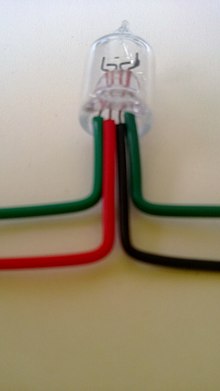Thermal converter
Thermo converters are measuring devices for determining the effective value of the electrical current . With a design suitable for the respective high frequency, they can be used up to the gigahertz range.
principle
Electricity flows through an electrical resistor (in the simplest case a heating wire). The Joule heat generated in the process heats up the resistor and is passed on to the environment. The heating that occurs with thermal inertia is proportional to the electrical power as long as the heat is released by free convection (and released by radiation does not yet play a role). The temperature increase generates a proportional DC voltage in a thermocouple .
This voltage can be displayed with a suitable voltage measuring device. In order to be able to read off the effective value of the heating current directly from it, a quadratic scale is required.
commitment
The advantage of this type of measurement is that it is largely independent of frequency and signal shape. Disadvantages, however, are a relatively long measuring time and the particularly high risk of the converter being destroyed if the measuring range is exceeded, because the heating increases quadratically with the measuring current. With the exception of a few applications in which no alternative measuring principle could be found for the current intensity , thermal converters are no longer used in technology.
The measuring principle is still used to measure the power of microwaves and laser beams .
literature
- Alois Krischke: Rothammels Antennenbuch . 12th edition. DARC Verlag, Baunatal, ISBN 978-3-88692-033-4 .
- MR. Tränkler: Pocket book of measurement technology . Oldenbourg-Verlag, Munich
